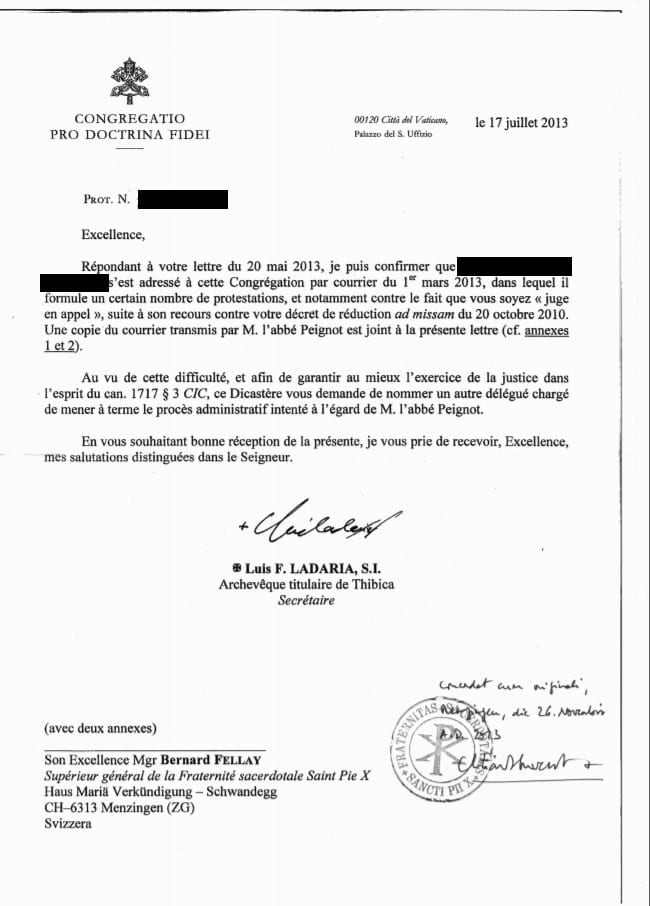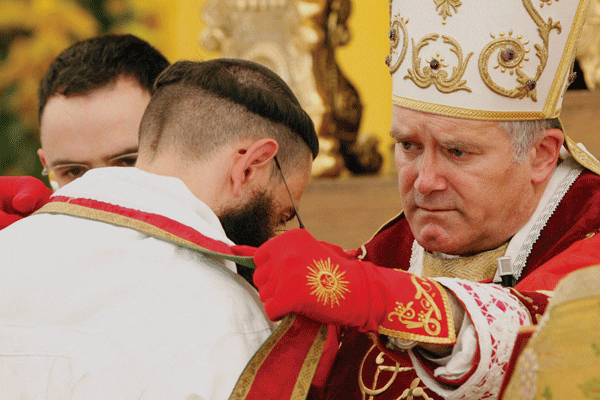ROME — A major report airing tonight on Swedish television documents four clerical sexual abuse cases, with previously unknown details on three of them, within the Society of St. Pius X, a traditionalist breakaway group founded by Archbishop Marcel Lefebvre in the wake of the Second Vatican Council.
At the center of the report are four different men. Three are priests, who remain in active ministry, and one is a former seminarian and volunteer at a church run by the Society of St. Pius X (SSPX) in Idaho who’s been sentenced to life in prison after being found guilty of abusing seven boys over the course of a decade.
They allegedly have abused at least 12 minors over the span of three decades, in France, Germany, Australia, Ireland, the United States, and the United Kingdom.
The report comes out just a day after the Vatican announced, with Pope Francis’s approval, that priests belonging to the traditionalist society, which currently has no legal standing within the Catholic Church, will be able to celebrate sacramentally valid marriages.
Since its inception in 1970, the SSPX has been a lightning rod in the life of the Catholic Church. It’s seen in a favorable light by some Catholics who harbor reservations about the liberalizing reforms unleashed by Vatican II (1962-65), but as retrograde and dangerous by others who object to its hard-line positions on matters such as ecumenism, inter-faith dialogue, religious freedom, and liturgical reform.
Some have also accused the SSPX of turning a blind eye to prejudices the Church has made strenuous efforts in recent decades to combat, including anti-Semitism.
Beginning with Pope Paul VI in the 1970s, every pope has made efforts to reach out to the Society and try to re-integrate it into the Church, seeing healing schism as a time-honored papal priority.
Most recently under Pope Francis, a hypothesis has been floated that the group might be brought back into the fold through the canonical structure of a personal prelature, which is currently held only by Opus Dei. That possibility had been suggested under emeritus Pope Benedict XVI.
It’s not clear whether the new revelations will set back those reunion efforts. In any event, they raise questions about the extent to which the society is committed to the fight against clerical sexual abuse, which has become a defining cause of both recent popes and also the Catholic Church around the world.
The Catholic Church today vows to respect a policy of “zero tolerance” with respect to both abusive priests and also bishops who engage in cover-ups.
(Producers of the Swedish program interviewed a variety of commentators and reporters on Catholic affairs. This reporter was among those interviewed, speaking not on the abuse allegations but the general situation of the SSPX and the Church.)
A source who claims to be a victim of one of the three priests featured in the Swedish TV report spoke with Crux on Monday night, on the condition of anonymity. He said that if he could speak to the Vatican department in charge of negotiations with the SSPX, he would tell them that they are being “irresponsible and hypocritical, in the sense that they [members of the Vatican department] know full well about these stories.”
That department is the Congregation for the Doctrine of the Faith (CDF), headed by German Cardinal Gerhard Müller, which includes a commission called Ecclesia Dei, responsible for outreach to the traditionalist body. Though officially headed by Müller, the commission is run on a day-to-day basis by Italian Archbishop Guido Pozzo.
The CDF is also the Vatican department with lead responsibility for handling cases of clerical sexual abuse.
As things stand, however, the Vatican’s influence over the SSPX is extremely limited. Father Eduardo Baura, a professor of Canon Law at the Pontifical University of the Holy Cross in Rome, told Crux that Rome has a “moral obligation to ask, demand, for something to be done, for the priest to be removed from ministry,” when accusations of abuse surface.
“But it has no legal power, because the SSPX doesn’t recognize the Vatican’s authority,” Baura said.
The 37-year-old survivor spoke with Crux over the phone, using the pseudonym “Andre,” the name which the makers of the program Uppdrag Granskning, produced by Sveriges Television, also employed.
Andre said that although he has little faith in the CDF, he also has no reason to believe Francis knows about the cases of sexual abuse within the society.
Producers divided their research into two episodes, one of which will air tonight (Wednesday), the second one next week. The second episode deals with the case of the former seminarian, Kevin Gerard Sloniker, who is today in prison.
Producers decided to omit the names of the priests, since they have not been found guilty by any civil court, identifying them as Father P, Father S and Father M. Two of those priests, P and S, reportedly have left the SSPX to join a splinter group led by British Bishop Richard Williamson, who, in 2009, gave an interview to the same Swedish program in which he cast doubt on the Holocaust.
Williamson was later expelled from the Society and founded his own group, popularly referred to as “the Resistance.”
P is identified as a French cleric, first accused of sexually abusing a minor in the 1980s. Uppdrag Granskning spoke to Andre about him, the abuse he says he endured at his hands, and efforts made by the SSPX to cover-up for the cleric.
In the program, Andre shares a secretly recorded conversation between him and a man identified as Fr. Niklaus Pfluger, today First Assistant to Swiss Bishop Bernard Fellay, who heads the SSPX. Pfluger’s position is considered the second most important within the society.
The recording reveals that the society knew P abused at least two other minors from 1987-1990, and that he was transferred from one parish to another.
Andre said his family did not report his own abuse to civil authorities.
“I think they should have done so, however … They did not, no,” Andre said. “I think it was because of the fear of going against the SSPX.”
That decision not to report the abuse is a pattern found in all three cases.
“[I decided to talk] to shake things up. [I’ve began doing so] back in 2005.” he told Crux. “I first complained about that priest just a few years after the abuse, in 1991, and then didn’t hear back about him for many, many years.”
In the recordings, Pfluger reads fragments from letters showing that P had been found guilty of sexual abuse and banned from ministry, particularly with children. Yet that sentence, he conceded, was never enforced.
“The major error on our part is rather why we did not implement it,” Pfluger says on the tape. “That’s precisely the problem. Father [Franz] Schmidberger changed his mind. That’s the problem.”
Schmidberger was the first successor of Lefebvre as head of the SSPX, and is currently the rector of the SSPX seminary in Germany. It was to him that Andre first wrote denouncing the abuses. In response, both he and his family were promised P would no longer be allowed to work with children.
Later in the tape, Pfluger is heard saying that his superiors repeatedly told P he was no longer allowed to minister to children, but “he did not believe it and continued.”
Twelve years ago, Fellay reportedly allowed P to organize camping trips for children, and it was a flyer about those trips that alerted Andre of the fact that he was still in contact with minors, despite the assurances given to his family.
When Andre wrote to Fellay expressing outrage, the bishop sent Pfluger to talk to Andre. It was that conversation he recorded, which allowed for the events to be reconstructed.

Documentation from the CDF, and revealed by the Swedish TV program, shows that the Vatican knew about the case and instructed Fellay to subject the accused priest to a canonical trial.
That decision, Andre said, is one reason he doesn’t “feel good about the Vatican.” He told Crux that it “makes no sense to me” that they would entrust the trial to the SSPX.
“They gave a mandate to Bishop Fellay to judge the man he’d covered up for,” he said.
P eventually was found guilty by the SSPX trial and transferred to the Maison Notre-Dame de Montgardin in the French Alps. It’s allegedly a retreat home, but critics say it doubles as a “golden jail,” where the priests found guilty of sexually abusing minors are sent to lead a life of “penitence and prayer.”
P refused to go, and, according to officials of the SSPX, he joined Williamson’s Resistance in 2014. Yet the Uppdrag Granskning program obtained pictures from as recently as 2015 that prove P took part in priestly ordinations of the Society held in Econe, Switzerland.
A second priest featured in the investigation, called M, was found by producers in Paris, where he’s stationed now, and Montgardin in the French Alps, where he’d been sent by the society when it was determined that he had engaged in what the SSPX described as “immature conduct” around children while stationed in Australia.
Before being sent to Montgardin, M had also served in Ireland, and the Swedish program presents a letter from a mother of one the children under his care there. She wrote that she didn’t know about actual abuses, but only “grooming” of at least one boy and one girl.
“I heard this from a priest who wished to warn me to keep my children away from the camps” under M’s care, the mother said.
In the letter, the mother also wrote about a rumor as to why the priest was hastily moved to Montgardin.
“He had been moved for molesting young boys,” she wrote. “This last information actually came from Germany.”
M is currently ministering in Paris. The SSPX reportedly denies that the case involves sexual abuse, yet they have declined to explain what was meant by the reference to “immature conduct,” or why he spent two years in the society’s retreat house in the Alps.
S, an Englishman, was accused of sexually abusing at least one boy in 2006 while stationed in Mulhouse in France. Reportedly, he was tried by the SSPX, found guilty, and barred from ministry. That same year he was transferred to a residence owned by the society in Bristol, and then to London in 2012.
S reportedly underwent years of therapy and counseling, until, in 2014, he left the SSPX to join the Resistance. He currently lives with Williamson in the coastal town of Broadstairs, some 80 miles from London. He’s once again in active ministry, and there are pictures of him celebrating Mass for this splinter group in Ireland and England.
The program airing tonight shows footage of Jean-Michel Faure, who was ordained a bishop by Williamson in 2015. In it, he’s asked about S.
“Of course, you must have no endangerment, you must not put anyone, any soul in danger,” Faure says. “If these precautions are taken, then you may try to save the soul of this priest.”
Among other questions raised by the Swedish TV report, the revelations may suggest yet another stumbling block to reconciliation between the Vatican and the SSPX, beyond well-known magisterial matters.
Observers may also wonder if the society will be willing to accept, and implement, the “zero tolerance” protocols now considered mandatory by the Catholic Church in the fight against child sexual abuse.
Editor’s Note: This article is one of two on the report by Uppdrag Granskning. A second, exploring Pope Francis’s attempts to bring the Society of Pius X into full communion with Rome, will be published tomorrow.















